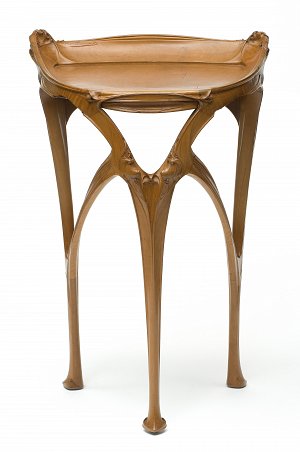
Architect Hector Guimard (1867-1942), manufacturer Ateliers d’Art et de Fabrication Guimard, Pedestal table, Paris, c. 1903
Poirier mouluré et sculpté. Don de Madeleine Pezieux au nom de Madame Léon Nozal, 1937. Inv. 32650
© Les Arts Décoratifs / photo : Jean Tholance
The first is chronological: this is the only museum in France which can offer such a vast panorama of the decorative arts from the Middle Ages to the present day. The team of curators’ joint reflection resulted in indispensable shifts in emphasis in the light of scientific research and the new interests which have emerged in recent decades and led to an evolution in our way of seeing. Thus the 19th-century collections, particularly from 1850 to 1880, and the 20th-century collections have had their exhibit spaces doubled. Numerous recent acquisitions have renewed the choice of works displayed. At any rate, our objective has never been to show more but always to show better. We are no longer the museum of ‘series’ we were in the past but a museum in which the eye is constantly accompanied and stimulated.

Manufacture de Saint-Cloud, Vase, vers 1700
Porcelaine tendre ; décor émaillé bleu sous couverte. Achat, 1899. Inv. 9042
© Les Arts Décoratifs / photo : Jean Tholance
This journey through time is structured by thematic presentations focussing on technical and stylistic concerns, and monographic displays punctuated by period rooms. The period rooms have always been one of the museum’s singularities. Even before it moved to the rue de Rivoli in 1905, they were a feature of the retrospective exhibitions organised by the Union Centrale des Arts Décoratifs at the Palais de l’Industrie in 1882. In this museum, the ten period rooms, the fruit of gradual and often chance acquisitions, provide homogenous visions of a period in which elements are combined with great archaeological accuracy. They were created with the collaboration of the interior designer François Joseph Graf.